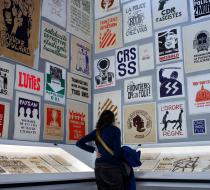Printing a Revolution: The Posters of Paris ’68 Favorite
During the major strikes and student uprisings in France that year, the École des Beaux-Arts turned itself into a workshop for revolutionary messages.
PARIS — Fifty years ago, almost to the day, students here began to strike over the rigidity and hierarchy of the French university system, defying the historical deference of young people to their elders; the same day, workers at a major factory near Nantes walked out.
Within days, the strikes spread to other universities and factories, and garbage collectors and office workers joined in. By mid-May, more than 10 million people across France were on strike, and the country had all but come to a standstill.
The protests of 1968 ushered in more than five years of social upheaval, intensifying an antiwar movement in Europe and contributing to the women’s liberation and gay rights movements. And it all started with a call to upend the old order.
“There was an idea that France was a class society and it had to be torn down,” said Éric de Chassey, a professor of contemporary art who curated, with Philippe Artières, “Clash of Images,” an exhibition at the Beaux-Arts de Paris. It showcases posters from those early days of social upheaval, as well as art and documents from subsequent protests for women’s rights and gay rights.
The show’s title refers to the way the 1968 protests evolved from uniting the left and people from different backgrounds — middle class and working class — to dividing them when the strikes ended and leftist factions re-emerged. But in those first months of protest, university students, factory workers and government employees joined intellectuals and teachers to try to fulfill the dream of making France a more egalitarian place.
The École des Beaux-Arts was at the center of the revolt. Many of the prestigious art school’s students and teachers occupied the 300-year-old stone structure on the Left Bank of the Seine: Rather than holding meetings only in the building’s vast rooms and courtyards, they turned the school into an atelier, or artists’ workshop, where they created protest art. The often arresting posters straddled the line between art and propaganda.
In keeping with the utopian ideals of collective work and anonymous authorship, the artists labored together to conceptualize, design and write slogans for the posters that framed their revolutionary sentiments.
“Someone would say ‘We need a poster that talks about immigration,’ ” Mr. de Chassey explained. “Then someone would propose a design, someone else would propose a slogan and then it would be discussed by a committee.”
The students printed hundreds or sometimes several thousand copies of the posters and taped them to lampposts and walls around Paris. In an era before the internet, the posters became a trusted way to communicate plans for action as well as the protesters’ political messages. There was little faith in electronic media at the time because it was state owned.
The strikes that began in May 1968 became the template for social protest in contemporary France, and although the fervent anti-establishment sentiments have faded, the mentality of struggle still resonates. The Beaux-Arts posters, on display through May 20, give a sense of the ferment of idealism, rebellion and rejection of the status quo that permeated French society and marked the second half of the 20th century.







